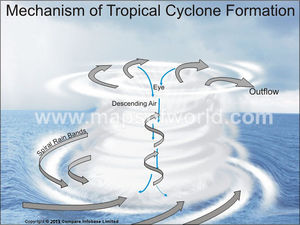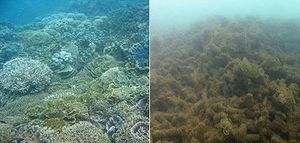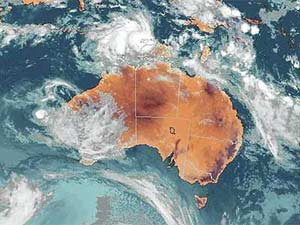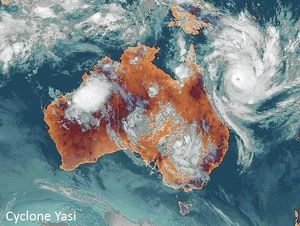Cyclones
Tropical Cyclones
What is a tropical cyclone?

Tropical cyclones are intense cells of low pressure accompanied by circular winds, thunderstorms, and heavy rain. They contain a central eye. The steep pressure gradient between the storm and surrounding air creates damaging storm surges of 2-5 m above the predicted level. The storm surge is located on the left of the storm in the southern hemisphere because winds spin in the clockwise direction and to the right in the northern hemisphere because winds circulate in the counterclockwise direction. The pathway of a cyclone is unpredictable, and it can make instantaneous switches. Cyclones can create waves up to 8-10 m depending on its wind strength. [2] A tropical cyclone starts out as a tropical depression, a low pressure system with no eye that contains unorganized storms and winds less than 34 knots, and becomes a tropical storm as it gains strength. It finally graduates to become a cyclone when winds reach a speed of 34 m/s. Depending on the location of the storm, a cyclone has different names: in the North Atlantic or North-Eastern Pacific Oceans, it is referred to as a hurricane; in the Western Pacific region, it is called a typhoon; and in the Southern Hemisphere and Indian Ocean, it is known as a cyclone.[3] Tropical cyclones can devastate coastal communities, infrastructure, and ecosystems. In coral reefs, tropical cyclones are a primary, physical damaging force. Cyclones can affect coral cover, species diversity, and reef productivity. Strong cyclones have the ability to shape the coral reef by affecting the benthic reef communities and underlying reef structure. Fortunately, coral reefs have a certain physical resilience against damaging cyclones. They can recover relatively quickly if there are not many outside stressors. [4]
What Kind of Damage Does It Do to Coral Reefs?
Reef damage varies with the intensity, distance, and location of a cyclone. With the right conditions, a cyclone can be catastrophic to a coral community and its inhabitants. This section needs much more information!
Effects on Water
Cyclones can increase sedimentation, alter local salinity, and cause short-term changes in sea level. High winds and torrential rainfall increase turbidity and result in more sedimentation on coral reefs. This sediment can negatively affect the growth of coral and even kill it by decreasing the permeability of light to coral, which is necessary for photosynthetic processes. Sedimentation can also decrease shelter availability for other organisms residing on coral reefs. Torrential rainfall can lower salinity levels. Corals can bleach from the resulting change of the water's pH. Finally, sea levels can also decrease with the low pressure generated by tropical cyclones. This can leave some corals exposed. Alternatively, when sea levels rise, some corals may not have enough sunlight, which is essential for the coral to absorb nutrients and energy.[5]
Erosion

Broken coral, sediment, and other organisms are displaced due to stronger ocean currents and result in some areas of the reef buried in sediment while others are left bare. Intense tropical cyclones with high storm surges can uplift these materials and push them up to the shore into features known as storm ridges. These are detrimental to atoll reefs because storm ridges have the potential to block off lagoons and induce deterioration of water quality. Stronger storm surges can also break off pieces of larger coral colonies. Reef fracturing depends on the location, shape, and strength of the coral itself: branching ReefInhabitants#Coral|corals are often more affected when compared to colonies of brain or boulder coral, since brain and boulder coral form more stable, massive colonies and create the foundational layer of coral reefs. [5]
Effects on Biodiversity
Cyclones affect species richness, distribution, and behavior. Most tropical cyclones do not directly kill reef fish. Reef fish are usually killed through the disruptions of their surroundings as discussed above. However, these mortalities are not selective, which means any number of species can be affected. This can be catastrophic if keystone and other important species are wiped out. Cyclones influence juvenile fish the most in shallow waters. When the density and distribution of these juvenile fish is disrupted, it negatively impacts the future species richness of the coral reef. The destruction of a coral reef is usually followed by a change in trophic levels of the fish community. Other reef species such as algae, sponges, and echinoderms are reduced in density, especially in shallow waters. Algae and sponges can be uprooted and displaced onshore due to strong winds and storm surges. [2]
Recovery
Coral reefs were built to withstand the physical damage of natural disasters like tropical cyclones. However, when reefs are weakened by outside stressors such as changing pH, salinity, and nutrient levels, coral reefs can take a long period of time to recover. Damaged coral reefs can take 5 to 40 years to recover, depending on the extent of the damage and how healthy the reef was originally.[7] Favorable conditions for growth also have to be present for the coral reef to recover. Salinity and sea levels need to return back to normal. Ideally, the reef should have connections to other healthy reefs, so that organisms and larvae can travel to reseed the damaged community. Without an outside source of larvae, a coral reef will take much longer to regrow. The regrowth of coral fragments is also necessary to repopulate the reefs. The regeneration of partially damaged coral colonies help reestablish old colonies of coral. The presence of human stressors should be minimal. Coral reefs that are unaffected by outside stressors have been shown to recover from tropical cyclones more quickly. [8]
Impacts on the Great Barrier Reef
Case Study: Cyclone Ingrid

Tropical Cyclone Ingrid hit the Great Barrier Reef in March of 2005. Ingrid ranged between a category 3 and category 5 cyclone with winds up to 250 km/s; however, the actual size of the cyclone was small: the core of the cyclone was only 10-15 km diameter. The winds created waves of up to 15 meters(m) in the open ocean and around 5m in the Great Barrier Reef. Unfortunately, Ingrid hit three different states in Australia.[10] This is the first time in history that a tropical cyclone hit this many states in Australia. The intensity of the damage was caused by the high winds in such a small area. While offshore reefs showed damage even at great depth, the inshore reefs took the brunt of the blow. Areas with less than 25 m/s winds suffered minimal damage, while areas with greater than 33 m/s winds encountered cataclysmic damage. In the worst affected areas, hard coral cover decreased 800%. The biodiversity decreased 250%, and the amount of coral recruits decreased by about 30%.[11]
Case study: Cyclone Yasi

Tropical Cyclone Yasi made landfall in Queensland, Australia in February of 2011. Yasi reached a category 5 cyclone with strong, damaging winds of 285 km/s. Reefs near the eye of the storm suffered the most damage, and the reefs south of the eye suffered more than the reefs to the north of the eye. Specifically, the 61 reefs that were around the peak winds were damaged the most. Out of these, 58 reefs suffered destruction to the living communities, and 47 of the reefs suffered from structural damage. Shelf position also affected the extent of damage to the coral: outer reefs experienced more devastation than mid-shelf reefs.[4] Some coral gardens around the Queensland area were reduced to rubble. Many coral heads, known as "bommies" in the area, were found lying on the ocean bed far away from where they were supposed to be. Because of these reasons, the damage was patchy, so some neighboring coral gardens remaining intact. These nearby corals can help facilitate the regrowth of the damaged coral gardens.[13] Cyclone Yasi's physical destruction ranged from minor tissue injuries on the edges of some coral colonies to complete removal of all sessile organisms. Fragile, fast-growing corals such as branching and plating corals endured the most damage, while more durable, slow-growing coral such as encrusting and brain coral suffered relatively less damage.[4] Yasi's damage to the coral gardens have already caused the coral trout to disappear from the area.[13] It is possible that Yasi may have caused more damage than any other storm since early 1900s.[4]> The extent of the damage could take anywhere between 10 to 20 years to restore good coral cover; however, some coral could take longer than that to fully recover. Months before Yasi, several floods swept through the same area, carrying sediment and pesticides into the ocean. This was compounded by the high tides caused by the cyclone. These pesticides and sediments could be potentially damaging to already fragile coral, causing latent death. Fortunately for people in the area, Queensland is not a popular reef site; therefore, there was not a severe impact to the tourism industry.[13]
Impacts on Caribbean Reefs
References
- ↑ "Tropical Cyclone Formation Mechanism." Maps of World. Compare Infobase, 04 Jan. 2013. Web. 18 Apr. 2013.
- ↑ 2.0 2.1 Harmelin-Vivien, Mireille L. "The Effects of Storms and Cyclones on Coral Reefs: A Review." Journal of Coastal Research (1994): 211-31. JSTOR. Coastal Education & Research Foundation, Inc. Web. 26 Feb. 2013.
- ↑ "TCFAQ A1) What Is a Hurricane, Typhoon, or Tropical Cyclone?" Atlantic Oceanographic & Meteorological Laboratory: National Oceanic & Atmospheric Administration. Hurricane Research Division, 15 July 2011. Web. 5 Apr. 2013.
- ↑ 4.0 4.1 4.2 4.3 Great Barrier Reef Marine Park Authority 2011, Impacts of tropical cyclone Yasi on the Great Barrier Reef: a report on the findings of a rapid ecological impact assessment, July 2011, GBRMPA, Townsville.
- ↑ 5.0 5.1 Scoffin, T.P. "The Geological Effects of Hurricanes on Coral Reefs and the Interpretation of Storm Deposits - Springer." Coral Reefs 12.3-4 (1993): 203-21. Springer Link. Springer-Verlag, 01 Nov. 1993. Web. 26 Feb. 2013.
- ↑ "Cyclones Also Fell Rainforests of the Ocean." The Sydney Morning Herald. Fairfax Media, 05 Feb. 2011. Web. 18 Apr. 2013.
- ↑ Hughes, T.P., A.H. Baird, D.R. Bellwood, M. Card, S.R. Connolly, C. Folke, R. Grosberg, O. Hoegh-Guldberg, J.B.C. Jackson, J. Kleypas, J.M. Lough, P. Marshall, M. Nystrom, S.R. Palumbi, J.M. Pandolfi, B. Rosen, and J. Roughgarden. "Climate Change, Human Impacts, and the Resilience of Coral Reefs." Science 301.5635 (2003): 929-33. Science Magazine. 15 Aug. 2003. Web. 26 Feb. 2013.
- ↑ "Recovery From Bleaching." Coral Reefs: Recovery from Bleaching. The Nature Conservatory, 2007. Web. 5 Apr. 2013.
- ↑ "Cyclone Ingrid Makes Impact Felt in Territory." ABC Northern Territory. ABC, 14 Mar. 2006. Web. 18 Apr. 2013.
- ↑ "Severe Tropical Cyclone Ingrid." Australian Government: Bureau of Meteorology. Commonwealth of Australia, n.d. Web. 5 Apr. 2013.
- ↑ Fabricius, Katharina E., Glenn De'ath, Marji Lee Puotinen, Terry Done, Timothy F. Cooper, and Scott C Burgess. "Disturbance Gradients on Inshore and Offshore Coral Reefs Caused by a Severe Tropical Cyclone." Diss. N.d. Abstract. Association for the Sciences of Limnology and Oceanography. N.p., 2010. Web. 26 Feb. 2013.
- ↑ "22. Cyclone Yasi." Web log post. Australia A Land Down Under. Blogspot, 06 Feb. 2011. Web. 18 Apr. 2013.
- ↑ 13.0 13.1 13.2 "ABC Rural." Long-term Coral Damage from Cyclone Yasi. ABC, 22 Mar. 2011. Web. 26 Feb. 2013.